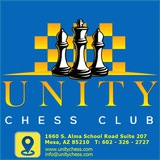Unity Chess Club
Jan Timman 2635 Alexander Beliavsky 2610 Linares 1993 Black to move
It is noticeable that the white queen and knight are on the queenside, leaving the king without sufficient defence. Black finds a way to bring additional pieces up, and forces White into an unpleasant defence:
Panic, which results in an irreparable weakening of the light squares. It was essential to cover them: 16.f3!. After 16...Rh6 17.g3 Qe3+ 18.Rf2 f5, Black still has some initiative, but no more than that.
The best chance was 20.e5!, trying to organise counterplay on the dark squares. Admittedly, after 20...d5! 21.Qe7 gxh4
22.Ne4 Bf5 23.Nf6+ Rxf6 24.Qxf6 Bxd3 25.cxd3 Re8 26.d4 hxg3 27.fxg3 Re6, Black has an extra pawn for no compensation.
22.Ne4 Bf5 23.Nf6+ Rxf6 24.Qxf6 Bxd3 25.cxd3 Re8 26.d4 hxg3 27.fxg3 Re6, Black has an extra pawn for no compensation.
20...Bh3 21.e5 Rxd6 22.exd6 Qf3 23.Qe4 Qxe4 24.Nxe4 Bxf1 25.Kxf1 gxh4 26.gxh4 Rd8 27.Ke2 f5 28.Ng3 Rxd6 29.Nxf5 Rf6 30.Ng3 Rf4 31.h5 Kf7 32.Ke3 Rh4 33.Kf3 Kf6 34.Ke3 Kg5 35.Kf3 Rf4+ 36.Ke3 Kg4 37.Ke2 Rf3
Unity Chess Club
Evgeny Vorobiov 2540 Nikolai Pokazaniev 2479 Russia 2006 White to move
Black is somewhat behind in development, and his Ba7 needs time to get into play. Therefore, White opens additional lines:
This attempt to bring his dark-squared bishop to life takes too much time, but after 18...d4 19.Na4, Black also has a difficult position – White threatens to play f4-f5, cramping Black over the entire board. In the future, the white knight will transfer via b2 to b4, after which, for example, he can unhurriedly prepare the advance of the g-pawn.
Here, the prophylactic 20.Kh1 looks promising (20.Bc4 was played in the game), but the energetic...
20...cxb4+ 21.Kh1 Qxe5 (or 21...Ng4 22.d6 Qe8 23.Ne4, with powerful centralisation) 22.axb4 cxd5 23.Nxd5! leads to a decisive advantage for White – the black queen is attacked wherever she goes
21.Kh1 cxd3 22.exf6 Qxf6 23.Qxd3 Bf5 24.Qc4 Qd4 25.Qxd4 Bxd4 26.dxc6 Rac8 27.Nd5 Rfe8 28.Bc3 Be4 29.Bxd4 Bxd5 30.Rf2
